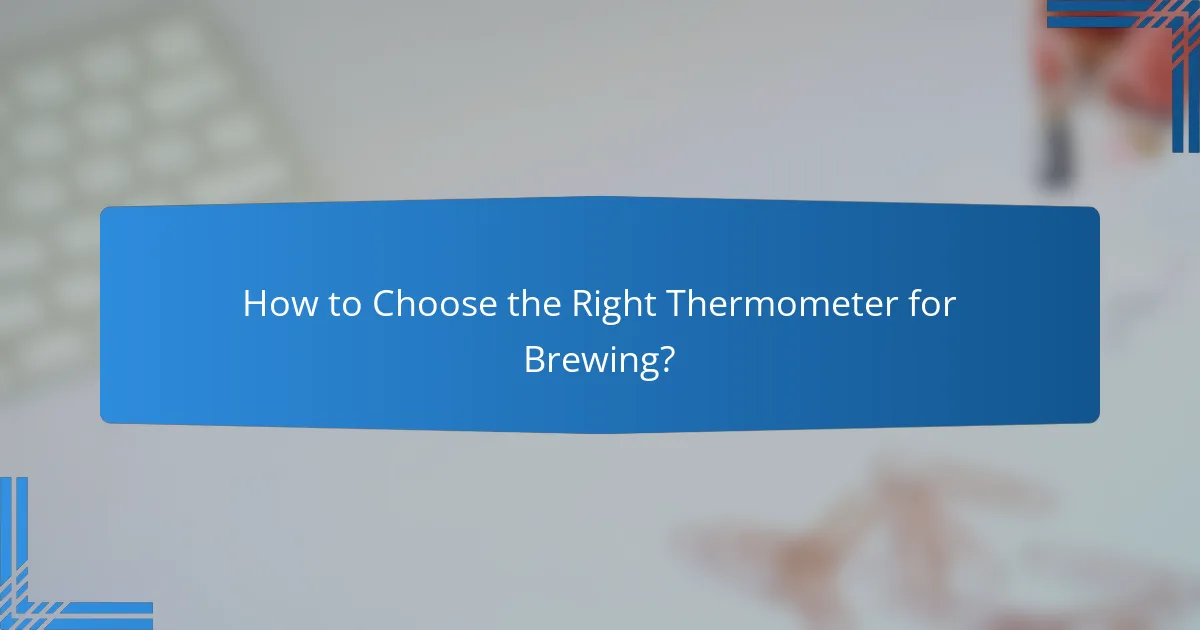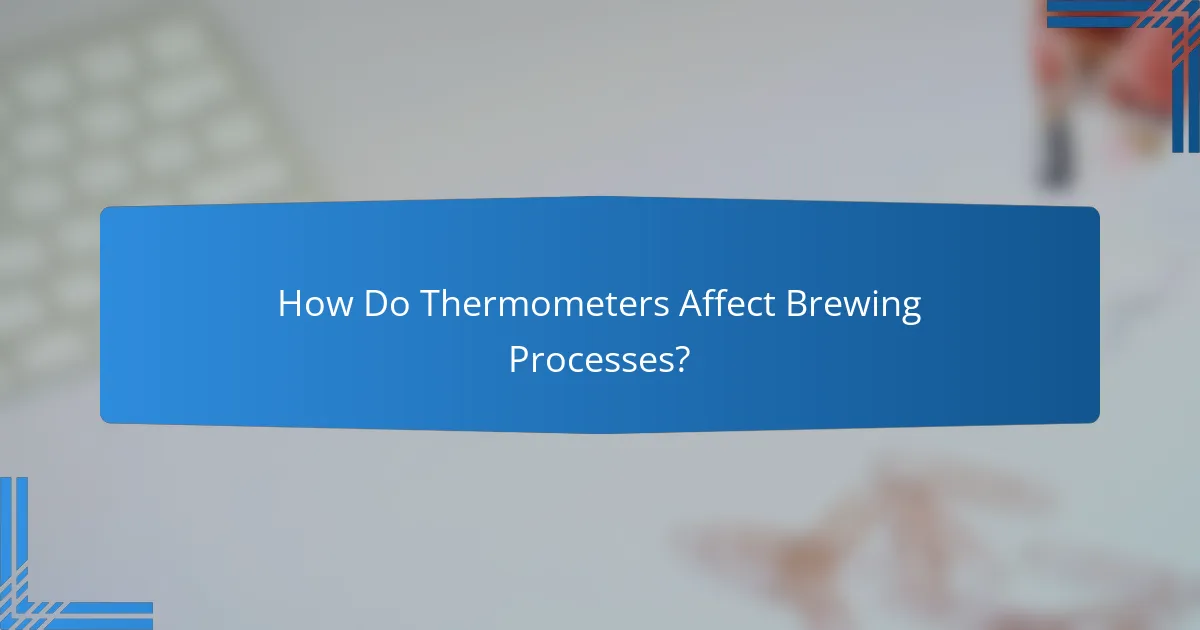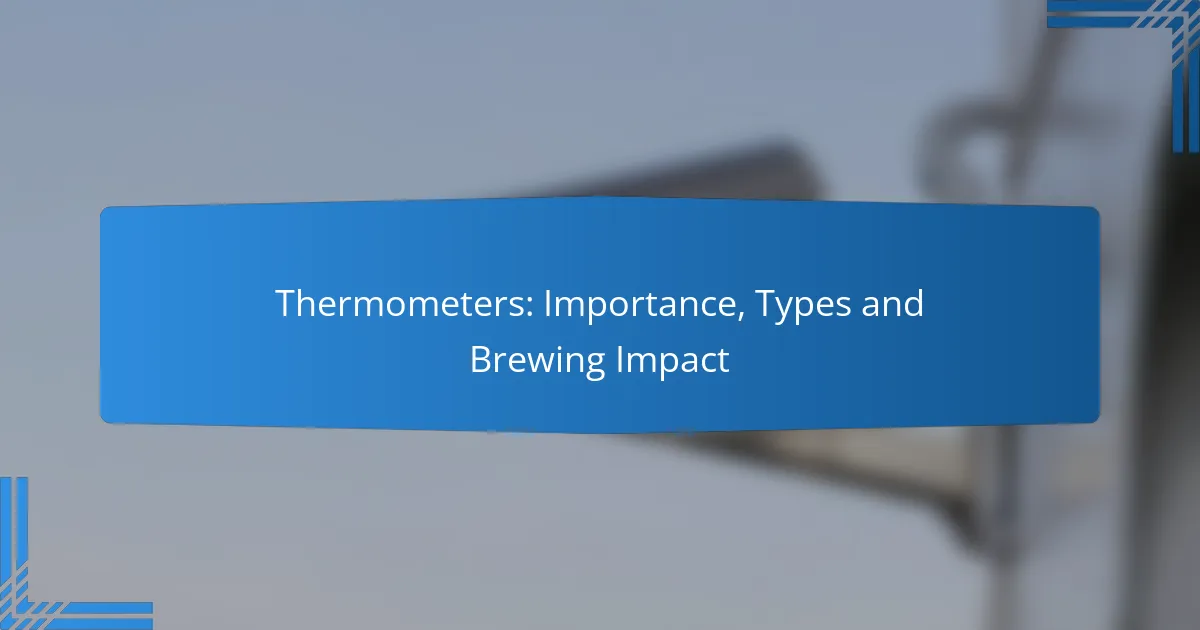Thermometers play a vital role in brewing by providing precise temperature control, which is essential for achieving high-quality results. With various types available, including digital, infrared, dial, and probe thermometers, brewers can select the best option based on their specific needs and brewing methods. Accurate temperature readings not only influence fermentation but also enhance flavor development, making the choice of thermometer critical for successful brewing.

Why Are Thermometers Important for Brewing?
Thermometers are crucial for brewing as they ensure precise temperature control, which directly affects the quality of the final product. Accurate temperature readings help brewers maintain optimal conditions throughout the brewing process, influencing fermentation and flavor development.
Ensure accurate temperature control
Maintaining the right temperature during brewing is essential for achieving consistent results. Different stages of brewing, such as mashing and fermentation, require specific temperature ranges to activate enzymes and yeast effectively. For example, mashing typically occurs between 62-72°C (144-162°F), while fermentation often thrives between 18-24°C (64-75°F) for ales.
Using a reliable thermometer allows brewers to monitor these temperatures closely, preventing fluctuations that can lead to undesirable outcomes. Digital thermometers with quick response times are particularly useful for ensuring accuracy during critical phases.
Impact on flavor and aroma
The temperature at which brewing occurs significantly influences the flavor and aroma profile of the beer. Higher temperatures during fermentation can produce esters and phenols, which contribute fruity and spicy notes, while lower temperatures tend to yield cleaner flavors. Understanding these effects helps brewers tailor their processes to achieve desired taste characteristics.
For instance, lagers are typically fermented at lower temperatures (around 8-12°C or 46-54°F) to produce a crisp, clean taste, while ales benefit from warmer fermentation (around 18-24°C or 64-75°F) to enhance complexity. This knowledge enables brewers to make informed decisions based on their flavor goals.
Prevent over or under fermentation
Temperature control is vital to prevent over or under fermentation, which can lead to off-flavors or incomplete fermentation. If the temperature is too high, yeast may become stressed, producing unwanted byproducts that affect taste. Conversely, too low a temperature can slow yeast activity, resulting in a stuck fermentation.
To avoid these issues, brewers should regularly check fermentation temperatures and adjust as needed. Using a thermometer to monitor the fermentation vessel can help maintain the ideal range, ensuring a healthy fermentation process and a balanced final product.

What Types of Thermometers Are Best for Brewing?
The best thermometers for brewing include digital, infrared, dial, and probe types, each offering unique advantages. Choosing the right thermometer depends on your brewing method, precision needs, and budget.
Digital thermometers
Digital thermometers provide quick and accurate temperature readings, making them ideal for brewing. They often feature a large display and can measure temperatures in seconds, which is crucial during critical brewing stages.
When selecting a digital thermometer, look for models with a wide temperature range and waterproof designs for easy cleaning. Battery life is another important factor; opt for models that offer long-lasting performance.
Infrared thermometers
Infrared thermometers allow you to measure surface temperatures without direct contact, which is useful for checking the temperature of boiling liquids or equipment. They are particularly handy for monitoring mash temperatures without disturbing the brewing process.
Keep in mind that infrared thermometers may not provide accurate readings for all surfaces, especially if they are shiny or reflective. Always check the manufacturer’s specifications for optimal usage conditions.
Dial thermometers
Dial thermometers are traditional devices that use a metal probe to measure temperature, displaying results on a dial. They are generally slower to respond than digital models but can be more durable and do not require batteries.
When using dial thermometers, ensure that the probe is properly calibrated for accurate readings. They are best suited for homebrewers who prefer a straightforward, no-frills approach to temperature measurement.
Probe thermometers
Probe thermometers are versatile tools that can be inserted into liquids or solids to monitor temperature. They often feature a digital display and can provide real-time readings, making them suitable for various brewing applications.
For best results, choose a probe thermometer with a quick response time and a long enough probe to reach the center of your brew. Regular calibration is essential to maintain accuracy over time.

How to Choose the Right Thermometer for Brewing?
Selecting the right thermometer for brewing is crucial for achieving consistent and high-quality results. Focus on the temperature range, response time, and calibration ease to ensure accurate readings during the brewing process.
Consider temperature range
The temperature range of a thermometer is essential for brewing, as different stages of the brewing process require specific temperatures. Most brewing thermometers should cover a range from around 0°C to 100°C (32°F to 212°F) to accommodate various needs, including mashing and boiling.
For more specialized brewing methods, such as brewing certain types of tea or coffee, consider thermometers that can measure lower temperatures, down to about -10°C (14°F). This flexibility allows for precise control over the brewing process.
Evaluate response time
Response time indicates how quickly a thermometer can provide an accurate reading after being placed in a liquid. For brewing, a response time of a few seconds is ideal, as it allows for quick adjustments during critical phases like mashing and fermentation.
Digital thermometers often have faster response times compared to analog ones. Look for models that specify their response time, ideally in the low seconds range, to ensure you can monitor temperature changes effectively.
Assess ease of calibration
Calibration is vital for maintaining accuracy over time. Choose a thermometer that is easy to calibrate, ideally with a simple adjustment mechanism or a clear instruction manual. This will help ensure that your readings remain reliable throughout multiple brewing sessions.
Some thermometers come with a calibration feature that allows you to set the correct temperature based on known standards, such as the freezing point of water. Regularly check and calibrate your thermometer, especially if you notice discrepancies in readings.

What Are the Best Practices for Using Thermometers in Brewing?
Effective use of thermometers in brewing is crucial for achieving optimal fermentation and flavor profiles. Following best practices ensures accurate temperature readings, which can significantly impact the quality of the final product.
Calibrate regularly
Regular calibration of your thermometer is essential to maintain accuracy. Depending on usage, calibrate your thermometer every few weeks or before significant brewing sessions. This can be done by comparing readings with a known accurate thermometer or using ice water and boiling water methods.
For example, if your thermometer reads significantly off from these benchmarks, adjust it according to the manufacturer’s instructions or replace it if calibration isn’t possible.
Position correctly in the brew
Correct positioning of the thermometer within the brew is vital for obtaining accurate readings. Place the thermometer in the middle of the liquid, avoiding contact with the sides of the vessel to prevent skewed results. This ensures that you measure the actual temperature of the brew rather than the temperature of the container.
Additionally, ensure that the probe is submerged adequately but not touching the bottom, as this can lead to incorrect readings due to heat conduction from the vessel.
Monitor temperatures consistently
Consistent temperature monitoring throughout the brewing process is key to achieving desired outcomes. Keep track of temperature changes during mashing, boiling, and fermentation, as each stage has specific temperature requirements that can influence flavor and alcohol content.
Utilize a digital thermometer with a quick response time for real-time monitoring, and consider using a brewing software or app to log temperatures over time. This data can help you identify trends and make adjustments in future brewing sessions.

How Do Thermometers Affect Brewing Processes?
Thermometers play a crucial role in brewing processes by ensuring that temperatures are accurately monitored and controlled. Proper temperature management affects the quality and consistency of the final product, influencing flavors and aromas during mashing, fermentation, and cooling stages.
Impact on mashing
During mashing, maintaining the right temperature is essential for converting starches into fermentable sugars. Typically, mashing occurs between 62°C and 72°C (144°F to 162°F), with specific temperature ranges affecting the enzyme activity. For example, lower temperatures favor beta-amylase, producing more fermentable sugars, while higher temperatures enhance alpha-amylase, resulting in a fuller-bodied beer.
Using a reliable thermometer helps prevent temperature fluctuations that can lead to incomplete conversion or undesirable flavors. Regularly calibrating your thermometer ensures accuracy, which is vital for achieving the desired mash profile.
Effect on fermentation
Temperature control during fermentation is critical for yeast health and activity. Most ale yeasts thrive between 18°C and 22°C (64°F to 72°F), while lager yeasts prefer cooler conditions around 7°C to 13°C (45°F to 55°F). Deviating from these ranges can lead to off-flavors or stalled fermentation.
Monitoring fermentation temperatures with a thermometer allows brewers to make timely adjustments, such as cooling or warming the fermentation vessel. This proactive approach helps maintain yeast viability and promotes a clean fermentation process.
Influence on cooling
Effective cooling is necessary to bring wort down to fermentation temperatures quickly and safely. Rapid cooling minimizes the risk of contamination and helps preserve volatile compounds that contribute to flavor. Thermometers assist in monitoring the cooling process, ensuring that the wort reaches the desired temperature efficiently.
Common methods for cooling include immersion chillers and plate chillers, which can achieve cooling times of around 15 to 30 minutes. Using a thermometer during this stage helps brewers avoid overshooting the target temperature, which can lead to unwanted fermentation issues.

What Are Common Mistakes When Using Thermometers?
Common mistakes when using thermometers can lead to inaccurate readings and poor results. Understanding these errors is crucial for achieving precise temperature control in various applications, especially in brewing.
Ignoring calibration
Ignoring calibration can significantly affect the accuracy of thermometer readings. Over time, thermometers can drift from their original settings due to wear and tear, temperature fluctuations, or physical impacts.
To ensure accurate measurements, regularly calibrate your thermometer against a known standard, such as ice water (0°C or 32°F) or boiling water (100°C or 212°F at sea level). This simple check can help maintain the reliability of your readings.
As a best practice, consider calibrating your thermometer every few months or whenever you suspect it may be off. This will help you avoid brewing mishaps caused by incorrect temperature readings.
